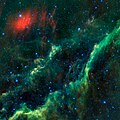Ficheiro:Menkhib and the California Nebula.jpg
Aparencia

Tamaño desta vista previa: 600 × 600 píxeles. Outras resolucións: 240 × 240 píxeles | 480 × 480 píxeles | 768 × 768 píxeles | 1.024 × 1.024 píxeles | 2.048 × 2.048 píxeles | 4.095 × 4.095 píxeles.
Ficheiro orixinal (4.095 × 4.095 píxeles; tamaño do ficheiro: 1,88 MB; tipo MIME: image/jpeg)
Historial do ficheiro
Prema nunha data/hora para ver o ficheiro tal e como estaba nese momento.
| Data/Hora | Miniatura | Dimensións | Usuario | Comentario | |
|---|---|---|---|---|---|
| actual | 12 de maio de 2010 ás 13:30 |  | 4.095 × 4.095 (1,88 MB) | Originalwana | {{Information |Description={{en|1=This infra-red image from NASA’s WISE (Wide-field Infrared Survey Explorer) features one of the bright stars in the constellation Perseus, named Menkhib (th |
Uso do ficheiro
A seguinte páxina usa este ficheiro:
Uso global do ficheiro
Os seguintes wikis empregan esta imaxe:
- Uso en ar.wikipedia.org
- Uso en en.wikipedia.org
- Uso en fa.wikipedia.org
- Uso en fr.wikipedia.org
- Uso en lb.wikipedia.org
- Uso en mk.wikipedia.org
- Uso en my.wikipedia.org
- Uso en pl.wikipedia.org
- Uso en pt.wikipedia.org
- Uso en ro.wikipedia.org
- Uso en ta.wikisource.org


